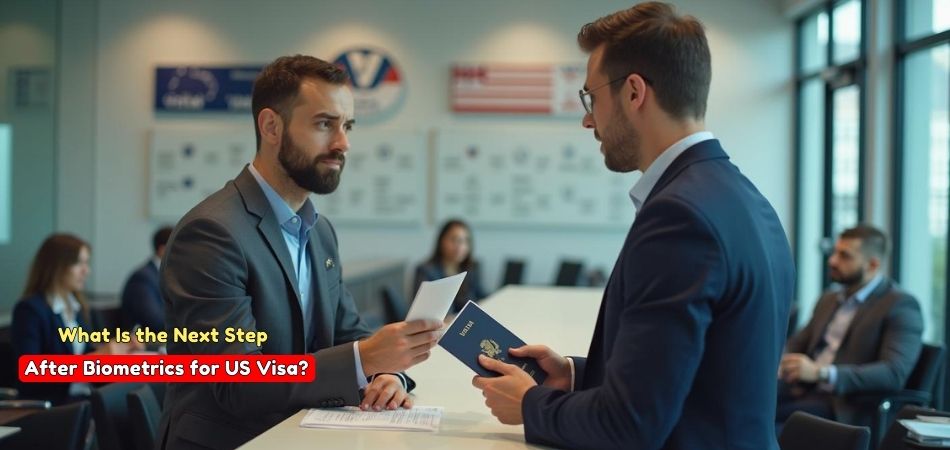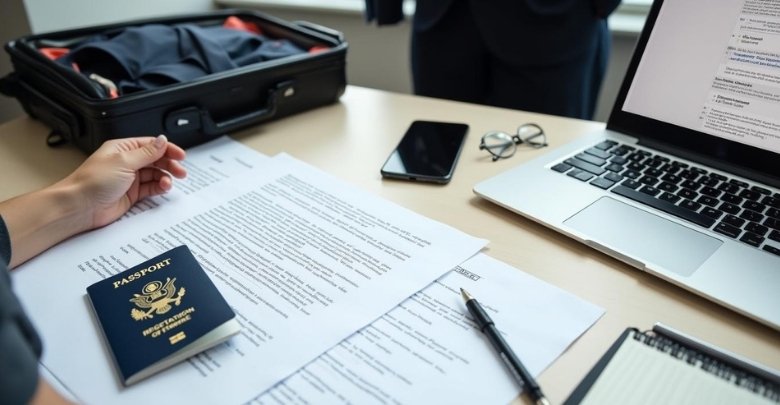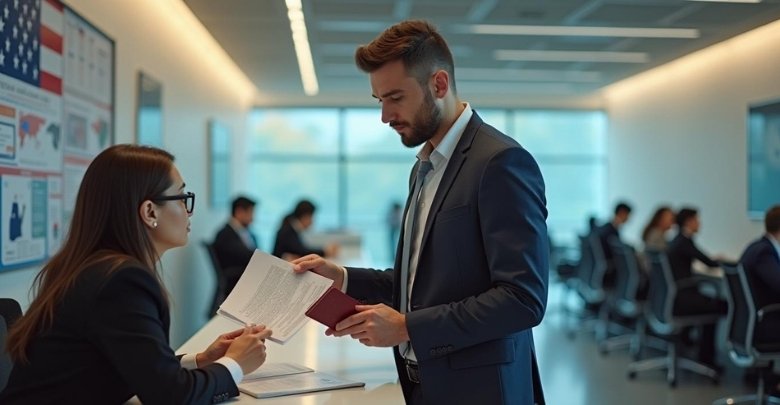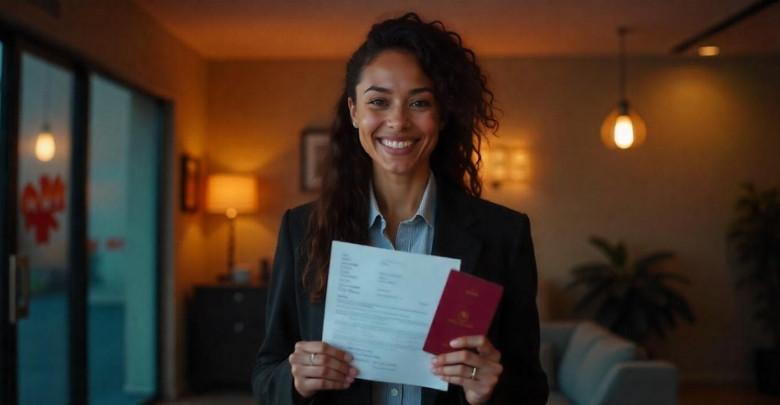US visa applications require biometric information, which serves as a secure method of verifying identity and maintaining system integrity. This mandatory step is a gateway to advancing your application. But, what is the next step after biometrics for US visa?
After completing biometrics during your visa interview, the next step is to wait for the US Embassy to process your application. They may request additional documents or provide updates on your visa status before making a final decision.
The timeline can vary, and it’s essential to stay informed and prepared. Keep reading to learn more about what to expect after biometrics and how to prepare for the final stages of your visa process.
What Is the Next Step After Biometrics for US Visa?
The biometrics process is a key part of the US visa application process. It helps verify identity and ensures security checks are completed properly. Once this step is completed, applicants often wonder what comes next in the process. The following is the detailed explanation:
Application Processing by the US Embassy
Once biometrics are completed, the US Embassy starts reviewing your application. They verify all submitted information before making any decision. This process ensures that your details match security and immigration records. Processing times vary, so staying informed is important.
Possible Requests for Additional Documents
The embassy may ask for extra documents to complete your application. These could include financial records, travel history, or employment verification. If requested, submit them quickly to avoid delays. Following instructions carefully helps in a smooth process.
Checking Your Visa Status Online
Applicants can track their visa status on the official US visa website. Entering your application details provides real-time updates on progress. It helps in understanding whether any further action is needed. Regularly checking prevents missing important updates.
Waiting for the Final Decision
After processing, the embassy decides on visa approval or denial. If approved, they notify you about passport collection or delivery. If denied, they provide reasons and possible next steps. Understanding the outcome helps in planning future applications.
Attending an Interview if Required
Some applicants may be asked to attend an additional interview. This can happen if more clarification is needed on documents or intent. Interviews are usually short but important for final decisions. Preparing answers properly can increase approval chances.
Preparing for Travel After Approval
Once the visa is approved, travel plans can be finalized. Booking flights, accommodations, and understanding visa conditions become priorities. For instance, if attending a conference in USA, ensure documents and schedules are organized. Careful planning helps in a smooth entry process.
Types of Documents Embassy Request to Complete the Visa Process
Submitting the right documents is crucial for a successful visa application. Sometimes, the US Embassy may ask for additional paperwork for verification. Providing accurate information helps speed up the process and prevents unnecessary delays.
- Passport Copies: A clear copy of your passport is often required for verification. It ensures your identity matches the details in your application.
- Financial Statements: Bank statements or income proof may be needed to confirm financial stability. This shows you can support yourself during your stay.
- Employment Verification Letter: A letter from your employer verifies your job position and salary. It proves that you have strong ties to your home country.
- Invitation Letter: An official invitation letter is required for business, academic, or family visits. It must state the purpose and duration of your stay.
- Travel Itinerary: A planned schedule of flights, accommodations, and activities is sometimes requested. It helps the embassy assess your travel plans and intent.
- Proof of Accommodation: Documents like hotel bookings or a host’s invitation confirm where you will stay. This reassures officials about your travel arrangements.
- Previous Visa Copies: Copies of previously issued visas show your travel history. They help in assessing your credibility and compliance with immigration laws.
- Educational Certificates: Academic records may be required for student or work-related visas. These verify your qualifications and eligibility for the intended purpose.
- Police Clearance Certificate: A certificate from law enforcement confirms your criminal record status. This is essential for security checks and immigration approval.
- Medical Examination Report: Health check results ensure you meet medical requirements for specific visa types. Some applicants need vaccinations or medical clearance before traveling.
Does Biometrics Guarantee a US Visa Approval?
No, biometrics does not guarantee US visa approval. It is just one step in the visa application process for identity verification. The embassy still evaluates other factors before making a final decision. Completing biometrics means progress, but approval depends on meeting all visa requirements.
Visa officers assess your purpose of travel, financial stability, and background before approval. Submitting complete and truthful documents increases the chances of a positive decision. Any missing or inaccurate information can lead to delays or denials. Understanding the process helps in preparing better for the outcome.
After biometrics, the US Embassy continues reviewing your application for eligibility. The US visa processing timeline after biometrics varies based on visa type and individual cases. Some applicants may receive quick decisions, while others might need additional verification. Checking your application status online helps in tracking progress.
A visa interview or extra documents may be required before approval. If requested, providing accurate information on time is very important. Each visa application is reviewed carefully before any final decision is made. While biometrics is essential, it does not determine the visa result.
How Can You Check the Status of Your Us Visa Application?
Waiting for a visa decision can feel stressful. Knowing how to check your application status helps in staying updated and prepared. There are multiple ways to track progress and ensure a smooth process. Here are the details:
Using the CEAC Website for Status Updates
The Consular Electronic Application Center (CEAC) is the official US government portal for visa tracking. Entering your DS-160 or DS-260 number provides real-time updates. The website displays different statuses like “Processing,” “Approved,” or “Administrative Processing.” Checking regularly helps in staying informed about any changes.
Checking Through the US Embassy Website
Each US embassy has a website with application tracking options based on location. Some embassies provide additional status updates for local applicants. Searching for your country’s US embassy website gives relevant information. The website may also list visa processing time estimates to help applicants.
Contacting the Visa Application Center (VAC)
Visa Application Centers (VACs) handle biometric appointments and document submissions. They provide information on whether documents have reached the embassy. Some centers offer phone or email support for inquiries. Checking with the VAC helps in understanding any next steps in the process.
Calling the US Embassy or Consulate Directly
Embassies offer phone support for visa status inquiries if online tracking is unclear. Calling during working hours ensures faster responses from embassy staff. Having your application number ready makes the process smoother. Embassy staff may provide updates or explain possible delays.
Tracking Visa Status via Email Notifications
Some embassies send automatic visa status updates through email for applicants. Checking emails regularly helps in receiving important notifications about processing. If no email is received, checking other sources is recommended. Ensuring your contact details are correct prevents missing important messages.
Using the CGI Federal Website for Updates
Applicants using CGI Federal for visa fee payments can track their application status online. Logging in with registered details provides access to important status updates. The site also offers appointment scheduling and document submission details. Keeping login credentials safe is essential for monitoring your visa progress.
What to Do if Your Us Visa is Denied After Biometrics?
A visa denial can be disappointing, but it does not mean the end of your journey. Being aware of the reasons for rejection helps in planning your next steps. There are ways to address issues and improve your chances in the future.
Recognize the Reason for Denial
Visa officers provide a denial letter explaining the reason for rejection. The letter includes the section of law under which it was denied. Common reasons include incomplete documents, weak financial proof, or failure to justify the purpose of travel. Identifying the issue helps in preparing a stronger application next time.
Check If You Can Appeal the Decision
Some visa denials can be appealed depending on the reason. Certain rejections, like administrative processing delays, may require additional documents instead of reapplying. The denial letter usually mentions if an appeal is an option. Checking with the US Embassy clarifies the next steps to take.
Correct Any Errors in Your Application
Errors in your application can lead to rejection by the visa officer. Reviewing all documents carefully before reapplying helps avoid mistakes. Ensure details like financial information, employment history, and travel purpose are accurate. Providing false or misleading information can result in future visa bans.
Gather Stronger Supporting Documents
A weak application may lack essential supporting documents for visa approval. Strengthening your application with additional financial proof or invitation letters improves chances. If traveling for a work event, a properly written company letter is important. Providing well-documented proof builds trust with visa officers.
Wait for the Right Time to Reapply
Reapplying immediately after denial is not always the best approach. It is important to fix the mistakes before submitting a new application. Making necessary improvements increases the possibility of visa approval. Waiting for the right time helps in avoiding repeated rejections.
Consider Alternative Visa Options
If one visa category is denied, exploring other options may work. Different visa types have different eligibility criteria and approval chances. Conference attendees, for example, may consider reapplying for USA conference visa under a business or visitor category. Submitting a formal invitation letter and proof of participation strengthens the new application.
Seek Professional Guidance if Needed
Visa consultants or immigration lawyers can provide valuable insights into improving applications. Their expertise helps in understanding complex visa regulations. Seeking help ensures that all necessary documents are correctly prepared. Professional advice increases the chances of a successful visa application.
Why Would the US Embassy Request an Additional Visa Interview?
Sometimes, the US Embassy may ask an applicant to attend another visa interview. This can happen for various reasons related to security, eligibility, or missing details. Being aware of why this happens helps in preparing for the next steps.
Incomplete or Missing Documents
An additional interview may be required if important documents were not submitted. The embassy needs complete paperwork to verify the applicant’s eligibility. Missing bank statements, employment letters, or sponsorship proof can cause delays. Providing all requested documents ensures a smoother process.
Clarification on Travel Purpose
Visa officers must confirm the applicant’s exact reason for traveling. If responses in the first interview were unclear, a second meeting is needed. Providing a well-documented itinerary supports the travel purpose. Clear explanations reduce doubts about the visit’s legitimacy.
Concerns About Strong Ties to Home Country
Applicants must prove they will return home after their visit. Weak evidence of strong ties may raise concerns about overstaying. Employment, family responsibilities, or property ownership can support return intentions. Additional interviews help officers verify these connections.
Background or Security Concerns
Security checks are part of the visa review process. If an applicant’s name matches a flagged record, further verification is required. The embassy may need extra time to confirm identity details. Attending the interview and providing truthful answers help resolve concerns.
Unclear Financial Stability
Applicants must prove they can afford their stay in the US. If financial statements are unclear, another interview may be scheduled. The embassy checks whether expenses can be covered without illegal work. Strong financial proof supports the visa application.
Inconsistencies in Previous Interview Answers
Conflicting answers during the first interview can lead to another one. Visa officers compare responses with submitted documents for accuracy. Honest and consistent answers increase approval chances. Preparing with correct information helps in avoiding misinterpretation.
Random Selection for Additional Screening
Some applications are randomly selected for extra security screening. This does not mean there is a problem with the application. The embassy conducts random checks to ensure strict immigration policies. Attending the interview and cooperating helps in processing the visa faster.
Best Way to Prepare for the Additional Us Embassy Interview and Answer Questions
Being called for an additional US Embassy interview can be stressful, but preparation can smooth the process. Knowing how to answer questions confidently is key to success. By staying organized and calm, you can improve your chances of a positive outcome. Here is a detailed breakdown of the process:
Review Your Previous Interview and Application
Checking previous answers helps in avoiding contradictions during the new interview. Visa officers compare responses with submitted documents for accuracy. Any mistakes or unclear details should be corrected before attending. Reviewing the application prevents miscommunication or inconsistencies.
Know the Reason for the Additional Interview
Knowing why the embassy requested another interview helps in addressing concerns. Common reasons include missing documents, unclear travel purpose, or security checks. Identifying the issue allows better preparation for specific questions. Addressing embassy concerns increases the chances of approval.
Gather All Required Documents Again
Bringing complete documents prevents further delays in the visa process. If additional paperwork was requested, ensure it is properly prepared. Carrying financial proof, sponsorship letters, or employment verification helps. Well-organized paperwork makes answering questions easier.
Practice Common Visa Interview Questions
Preparing for common questions improves confidence and clarity during the interview. Officers may ask about travel plans, financial situation, or home country ties. Practicing answers helps in delivering accurate responses. Staying calm ensures better communication with the officer.
Dress Professionally and Arrive on Time
Dressing formally creates a positive impression during the visa interview. A neat and professional appearance shows seriousness about the application. Arriving early prevents last-minute stress and ensures timely check-in. Being punctual demonstrates responsibility and respect for the process.
Answer Questions Honestly and Confidently
Providing truthful answers builds trust with the visa officer. Speaking clearly and confidently improves understanding and reduces misunderstandings. If a question is unclear, asking for clarification is acceptable. Honest responses strengthen credibility and approval chances.
Remain Calm and Respectful
Maintaining a composed attitude helps in handling unexpected questions. Getting nervous or defensive may create unnecessary doubts about the application. Speaking politely and showing patience is essential. A positive attitude leaves a good impression on the officer.
Be Prepared for Possible Additional Delays
Sometimes, another review is needed even after the second interview. Processing times vary based on visa type and applicant background. Checking the application status regularly helps in staying updated. Patience is necessary while waiting for the final decision.
What Are the Key Things to Do Once Your Visa is Approved?
The approval of your US visa is an exciting moment, but there are several steps you have to take next. Make sure you complete everything correctly to avoid problems later. Follow these simple instructions to make the most of your approval:
Collect Your Passport and Visa Carefully
Once approved, check how and when to collect your passport from the embassy or visa center. Some embassies offer courier delivery, while others require in-person pickup. Verify all details on your visa, including name, validity, and visa type. If any errors exist, contact the embassy immediately for corrections to avoid future issues.
Be Aware of Visa Conditions and Validity
Review your visa’s validity, allowed stay duration, and number of entries permitted. Ensure you follow all rules to avoid immigration violations. Overstaying or misusing your visa can lead to penalties or future denials. Knowing these conditions helps in planning a compliant and hassle-free trip.
Book Your Flight and Accommodation Early
After receiving your visa, confirm your travel dates and book flights in advance. Securing tickets early helps in getting better prices and availability. Choose accommodations near your planned activities, whether for tourism, business, or an event. Keeping booking confirmations handy ensures a smooth check-in process upon arrival.
Arrange Travel Insurance and Medical Coverage
Having travel insurance protects you from unexpected medical emergencies, trip cancellations, or lost luggage. Some visas may require specific insurance coverage before entry. Check if your existing health insurance includes international coverage or purchase a separate plan. Carry proof of insurance to present at immigration or during medical emergencies.
Prepare Important Travel Documents for Entry
Ensure all necessary documents, including your passport, visa, travel itinerary, and invitation letters, are well-organized. Keep both physical and digital copies for emergencies. Having backup copies stored on your phone or email ensures easy access. Proper document preparation helps avoid unnecessary delays at immigration checkpoints.
Exchange Currency and Plan Your Expenses
Convert some money into US dollars before traveling for immediate expenses upon arrival. Check exchange rates in advance to get better deals. Carry a mix of cash and an international debit or credit card for convenience. Understanding daily expenses helps manage your budget efficiently while in the US.
Pack According to US Travel and Airline Guidelines
Follow airline baggage rules and TSA guidelines to avoid packing prohibited items. Carry travel essentials like chargers, power adapters, and weather-appropriate clothing. Pack important medications along with their prescriptions if required. Proper packing prevents unnecessary hassles at airport security checks.
Prepare for Immigration and Entry Procedures
Know what to expect at the US port of entry, including possible questions about your trip’s purpose and stay duration. Be ready to provide supporting documents if requested by immigration officers. Stay calm and answer truthfully to avoid delays. Following entry procedures correctly ensures a smooth transition into the country.
Frequently Asked Questions
After completing the biometrics process for your US visa application, you may have several questions about what happens next. Understanding the steps after biometrics helps ensure a smooth process and prevents unnecessary delays. Below are some frequently asked questions with detailed answers to guide you through the next phase.
How Long Does It Take for the Embassy to Process Visa After Biometrics?
The processing time varies based on visa type, application complexity, and embassy workload. Some applications are processed within days, while others take weeks. Administrative processing or document requests can further extend the timeline. Checking your application status regularly helps in staying updated.
Will I Be Notified When My Visa Is Approved?
Yes, the embassy notifies applicants once a decision is made. Notifications are sent via email or through the application tracking system. If approved, you will receive instructions for passport collection. Checking your status online helps track updates faster.
Can I Contact the Embassy to Expedite My Visa Process?
Most embassies only expedite visa processing in emergency situations. If urgent travel is required, submit a request with valid reasons. Business trips, medical emergencies, or academic deadlines may qualify. Approval for expedited processing is at the discretion of the embassy.
What Happens If My Visa Is Delayed After Biometrics?
Visa delays can occur due to background checks, document verification, or embassy workload. If delayed, check your application status online for updates. Contacting the embassy may help, but patience is required. Ensuring all documents are complete can reduce delays.
Does the Type of Visa Affect Processing Time After Biometrics?
Yes, different visa types have different processing times. Tourist and business visas are generally processed faster than work or student visas. Background checks for employment-based visas may take longer. Checking embassy processing estimates gives a better idea of wait times.
Will I Need Another Biometrics Appointment If My Visa Is Delayed?
In most cases, biometrics are valid for a specific period and do not need to be repeated. However, if processing takes too long, the embassy may request new biometrics. This depends on individual cases and security requirements. The embassy will notify you if needed.
What If I Change My Travel Plans After Biometrics?
If travel plans change, inform the embassy only if it affects your visa purpose. Changes in trip duration or sponsorship details may require updates. However, minor changes usually do not impact the process. It’s best to stick to original plans if possible.
Can I Apply for Another Visa While Waiting for My Current One?
Applying for another visa while waiting for approval is possible but not recommended. Multiple applications can cause confusion and delays. The embassy may question why multiple visa applications exist. Waiting for a decision before reapplying is usually the best approach.
What If I Made a Mistake in My Application After Biometrics?
If errors are found after biometrics, inform the embassy immediately. Some mistakes can be corrected before a final decision is made. Serious errors may require a new application. Providing correct information helps prevent unnecessary rejections.
Final Thoughts
The US visa application process does not end with biometrics; it continues with several important steps. Knowing what is the next step after biometrics for US visa ensures applicants stay informed and prepared. After biometrics, the US Embassy reviews the application, possibly requesting additional documents or an additional interview.
Checking visa status online, responding to Embassy requests promptly, and preparing for possible delays can improve approval chances. If granted, applicants must review visa details, arrange travel, and follow entry procedures. Those denied should identify the reasons, strengthen their documents, and consider reapplying when ready. Careful planning at each stage leads to a smoother experience. Staying proactive and well-prepared will help you obtain a US visa.

